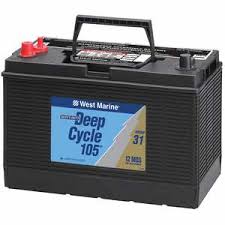Intro
Quick Navigation
In the world of batteries and automobiles, some types are more powerful than the rest. Regular batteries have specific content, mostly acidic electrolytes that power and ensures the functionality of an automobile. However, a unique type stores a greater amount of electricity and releases electric current steadily for performance; it is called a Deep Cycle Battery.
The deep cycle battery is used to power appliances; it is further incorporated into systems like Photovoltaic solar panels, hydroelectric generators, wind power systems, and even hybrid renewable energy systems. Usually, it powers DC loads, which is why sizing the battery bank is essential. With the incredible things about this battery, there are many concerns, including “what are deep cycle battery amp hours?”
Click here to discover how to charge a Boat’s Deep Cycle Battery.
What are the Components of a Deep Cycle Battery and its Lifespan?
In the last century, battery technology hasn’t received new improvements; you will find batteries with lead plates and acidic electrolytes. The only difference between now and then is that more manufacturers have emerged with different battery selling potentials and markets.
Generally, batteries work using simple chemistry – a reaction between positive and negative terminals to produce electricity. Thus, the electricity provided generates electric currents needing power functions in a car, bike, or boat.
However, the thickness of the positive lead plate plays a huge role in the battery’s lifespan. Most of these manufacturers pay little or no attention, so there are always bad batteries on the market. When it comes to Deep Cycle Batteries, there is a heavy thickness to prevent a condition called “Positive Grid Corrosion” that affects many conventional batteries.
Read here on what causes Battery Corrosion.
Therefore, it could be agreed that Deep Cycle Batteries was designed to provide long-lasting years of electric currents needed to power appliances. They are reliable; however, they must be maintained and handled with care.
Due to the need for proper maintenance, sizing the battery bank often would avert some situations. For instance, you won’t have to deal with battery failure problems due to freezing, undercharging, overcharging, vibration, etc.
What is an Amp Hour?
An Amp Hour is a unit to describe the standardized discharge rate by measuring electric current with time. Usually, all Deep Cycle Batteries are rated in Amp-Hours. Thus, it means 1 amp for 1 hour or 20 amps for 1/20 of an hour. It simply measures current with time (in hours).
How to Calculate a Deep Cycle Amp Hour?
Generally, most solar electric and power backup systems’ manufacturers (including some deep cycle batteries) accept 20 hours for AH. This accepted measurement implies that a rated amperage will only work within that 20 hours’ time frame or less than 10.5V or dead. In some cases, you will find the rating at 100 hours to look more dependable.
Moreover, the reason why amp-hours are specified at a rate is that Pukert Effect comes into play. This phenomenon solely describes the response of a battery to amp-hours, i.e., the faster the discharge, the lower the AH.
What Factors are Used to Size Deep Cycle Battery?
In a bid to understand Deep Cycle Battery Amp Hours better, mentioning the factors that affect the battery bank’s sizing is crucial.
- Electrical Usage per Day
Deep Cycle Battery produces an amount of energy needed to run daily; however, you must know that particular amount. Electrical Usage per day has a significant role to play in the efficiency of the battery’s amp-hours. The best way to do that is to evaluate electronic appliances in an automobile – the load in use and how long to be used.
Every piece of information obtained from evaluating electronic loads per day should be stored properly. There will be a time you would have to review the evaluations and find the differences. With these differences, you could tell the electronic appliance that consumes more energy per day.
- Days of Autonomy
A battery backup is also another factor that influences the amp-hours of a Deep Cycle Battery. This battery backup is a function of the days of autonomy. For instance, when you cannot charge the battery, the days of autonomy would be a reserve that you could fall back on – take it as additional storage.
Determining the days of autonomy vary from one electricity generator to another. In the wind-power generator, the days of autonomy are specifically the day where there is little or no wind to power the device. Likewise, keep records because you will always need them for comparing amp-hours.
- DOD Unit
Every Deep Cycle Battery bank has a Depth of Discharge (DOD) unit. It is a factor that distinguishes them from Shallow Cycle Batteries. Generally, DOD is the lowest minimal available energy to a Deep Cycle Battery; hence, you should know it is significant to the amp-hours.
With that in consideration, you should always ensure that a Deep Cycle Battery is not discharged below the 50% Capacity. If you plan to use the battery off-grid, a 25% DOD will increase the battery’s lifespan.
- Ambient Temperature
Usually, Temperature is a factor that influences the lifespan and capacity of Deep Cycle Batteries – freezing temperatures reduce battery capacity, while hot temperatures shorten lifespan. Therefore, there is a need to strike a balance for an optimum amp-hour evaluation – an ambient temperature.
Flooded Lead-Acid Deep Cycle Batteries are not ideal in freezing conditions; however, Sealed Deep Cycle Batteries could withstand some cold. There is a reduction in its capacity in the latter case, but it is the only suitable choice for such a condition. Hence, you should know what to use at the right place.
Conclusion
By now, some things shouldn’t sound alien to you – like, “What are Deep Cycle Battery Amp Hours?” The reason is that every piece of information needed to determine that coefficient governing a Deep Cycle Battery’s life has the provided in the article. All you need to do from here is to calculate and find a value for your battery.

